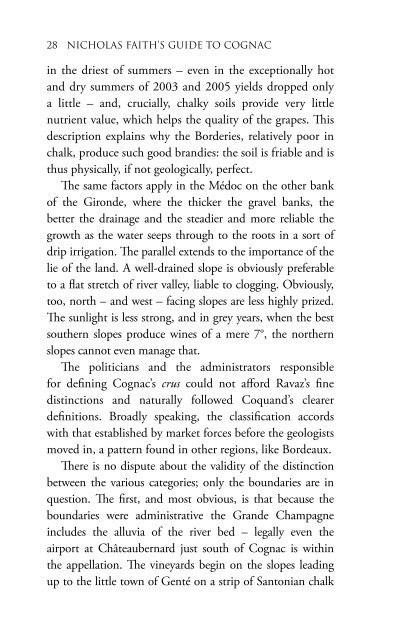Create successful ePaper yourself
Turn your PDF publications into a flip-book with our unique Google optimized e-Paper software.
in the driest of summers – even in the exceptionally hot<br />
and dry summers of 2003 and 2005 yields dropped only<br />
a little – and, crucially, chalky soils provide very little<br />
nutrient value, which helps the quality of the grapes. This<br />
description explains why the Borderies, relatively poor in<br />
chalk, produce such good brandies: the soil is friable and is<br />
thus physically, if not geologically, perfect.<br />
The same factors apply in the Médoc on the other bank<br />
of the Gironde, where the thicker the gravel banks, the<br />
better the drainage and the steadier and more reliable the<br />
growth as the water seeps through to the roots in a sort of<br />
drip irrigation. The parallel extends to the importance of the<br />
lie of the land. A well-drained slope is obviously preferable<br />
to a flat stretch of river valley, liable to clogging. Obviously,<br />
too, north – and west – facing slopes are less highly prized.<br />
The sunlight is less strong, and in grey years, when the best<br />
southern slopes produce wines of a mere 7°, the northern<br />
slopes cannot even manage that.<br />
The politicians and the administrators responsible<br />
for defining <strong>Cognac</strong>’s crus could not afford Ravaz’s fine<br />
distinctions and naturally followed Coquand’s clearer<br />
definitions. Broadly speaking, the classification accords<br />
with that established by market forces before the geologists<br />
moved in, a pattern found in other regions, like Bordeaux.<br />
There is no dispute about the validity of the distinction<br />
between the various categories; only the boundaries are in<br />
question. The first, and most obvious, is that because the<br />
boundaries were administrative the Grande Champagne<br />
includes the alluvia of the river bed – legally even the<br />
airport at Châteaubernard just south of <strong>Cognac</strong> is within<br />
the appellation. The vineyards begin on the slopes leading<br />
up to the little town of Genté on a strip of Santonian chalk<br />
that separates the alluvium from the Campanian. But it is<br />
the sleepy little town of Segonzac several miles south of the<br />
river which is the ‘capital’ of the Grande Champagne (not<br />
surprisingly, the only sizeable merchant located in the town<br />
is Frapin, which sells only cognacs from its estate in the<br />
heart of the Grande Champagne). The outer boundary, the<br />
further bank of the River Né towards Archiac, officially in<br />
the Petite Champagne, produces cognac arguably superior<br />
to some from parts of the Grande Champagne. But most<br />
of the blenders agree with Maurice Fillioux that the Grande<br />
Champagne should never produce bad brandy and that its<br />
boundaries are broadly correct. Francis Gay-Bellile, then<br />
of the Bureau Viticole, did not sound ridiculous when he<br />
affirmed that they are 95 per cent accurate.<br />
No one disputes the borders of the Borderies, nor the<br />
quality of the brandies they produce, two-thirds of which<br />
used to be bought by Martell and Hennessy – though today,<br />
Martell’s overstocking while it was owned by Seagram has<br />
allowed other firms, notably Courvoisier, to take a much<br />
increased share. As we saw, the vast region of the Fins<br />
Bois has become more clearly defined. None of the best<br />
and biggest firms buys Fins Bois from the west of Saintes,<br />
brandies they find too ‘foxy’ – with an unappetizing<br />
earthiness. Few reputable firms buy much brandy from the<br />
Bons Bois and serious firms concentrate their purchases in a<br />
narrow strip to the south around Chevanceaux and Brossac.<br />
If the terroirs of the <strong>Cognac</strong> region vary wildly, the grape<br />
varieties used have only changed a couple of times in the past<br />
four centuries. When <strong>Cognac</strong> first made its name the region<br />
was largely planted with the Balzac grape, which had several<br />
characteristics found in today’s favourites. It was highly<br />
productive; it was a Mediterranean variety and thus did not


